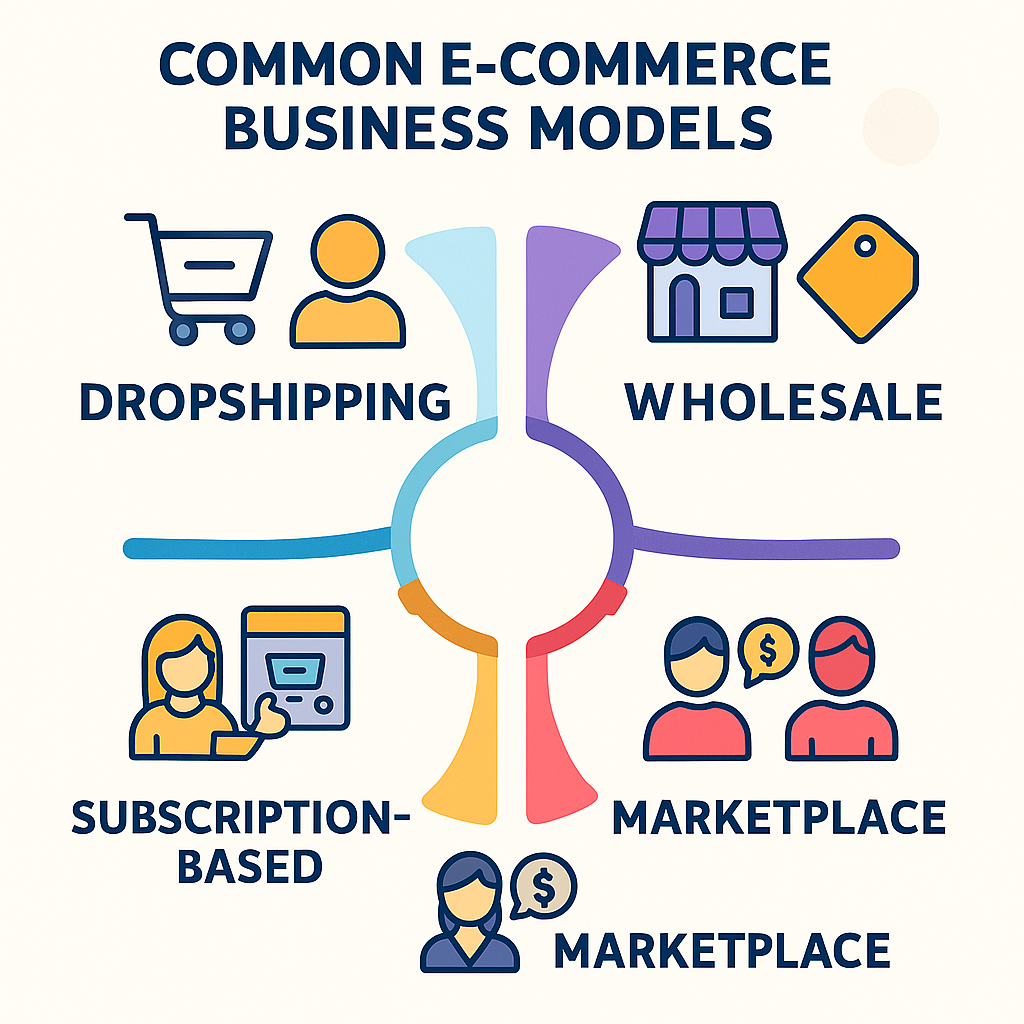In today’s digital-first economy, e-commerce has transformed how we shop, sell, and do business. Whether you’re a consumer buying groceries online or a company sourcing products from a global supplier, you’re participating in the vast world of e-commerce. But what exactly is e-commerce, and what are the different types and models behind it?
In this blog, we’ll explore the types of e-commerce, various ecommerce trends and business models, and their real-world examples to help you understand how to build or optimize your digital venture. We’ll also touch upon retail marketing, which plays a key role in online success.
What Is E-Commerce and E-Business?
At its core, e-commerce (electronic commerce) refers to the buying and selling of goods or services using the internet. This includes everything from online retail stores to digital marketplaces and subscription services.
On the other hand, e-business is a broader term encompassing all digital aspects of business operations, not just buying and selling. It includes inventory management, customer service, supply chain operations, and marketing efforts conducted online.
Example: Running an online clothing store is e-commerce. Using software to manage that store’s supply chain, customer relationships, and accounting is e-business.
Understanding both e-commerce and e-business types is crucial for long-term digital growth.
Also Read: Shopify Plus Ecommerce Agency
Categories of E-Commerce
There are five primary categories of e-commerce, based on the parties involved in the transaction. Here’s a quick breakdown:
| Category | Full Form | Description | Example |
| B2B | Business to Business | Transactions between companies | Alibaba, Salesforce |
| B2C | Business to Consumer | Businesses selling directly to end customers | Amazon, Flipkart |
| C2C | Consumer to Consumer | Individuals selling to other individuals | eBay, OLX |
| C2B | Consumer to Business | Individuals offering products/services to companies | Upwork, Fiverr |
| B2G | Business to Government | Companies providing products or services to government agencies | SAP, IBM (Govt. deals) |
These categories of e-commerce help businesses define their audience and marketing approach. They also serve as a guide for choosing the most suitable e-commerce business model.
Common E-Commerce Business Models
An e-commerce business model defines how a business earns revenue online. Choosing the right model can determine your success or failure. Let’s explore the most common models:

1. Dropshipping
A retailer doesn’t keep goods in stock but transfers orders to third-party suppliers who ship directly to customers.
- Pros: Low overhead
- Cons: Low control over inventory and delivery
2. Wholesale
Businesses buy goods in bulk from manufacturers and sell them to consumers or other companies.
- Pros: Better profit margins
- Cons: Requires storage and inventory management
3. Private Labeling
A company manufactures products under your brand name.
- Pros: Brand control
- Cons: Requires significant investment and marketing
4. Subscription-Based
Customers pay a recurring fee to receive products/services regularly.
- Pros: Predictable revenue
- Cons: High churn rate if not maintained well
5. Marketplace
You create a platform where third-party sellers list and sell their products.
- Pros: Scalability
- Cons: High competition and regulatory responsibilities
Understanding different e-commerce models helps businesses align strategy with customer expectations and product offerings.
Types of E-Commerce with Real-World Examples
Let’s bring theory into real life by mapping the types of e-commerce with examples of companies dominating the space.
| Type | Real-World Example | Description |
| B2C | Amazon, Walmart | Retailers selling to individual consumers online |
| B2B | Alibaba, IndiaMART | Wholesale and supplier platforms |
| C2C | OLX, eBay | Peer-to-peer selling or reselling |
| C2B | Upwork, Shutterstock | Freelancers or content creators offering to businesses |
| B2G | SAP, Oracle | Software and services provided to governments |
These examples illustrate how different e-commerce business models function in real-world scenarios. Depending on your goals, you might choose one or even combine multiple types of e-commerce.
The Role of Retail Marketing in E-Commerce
So, what is retail marketing, and why is it essential for e-commerce success?
Retail marketing is the set of activities aimed at promoting and selling products directly to consumers. In the online space, this includes:
- SEO and content marketing
- Social media promotions
- Email campaigns
- Retargeting ads
- Customer loyalty programs
Effective retail marketing bridges the gap between your e-commerce model and consumer demand. It ensures your product is visible, your messaging resonates, and your brand builds trust.
For example, D2C brands like Warby Parker and Dollar Shave Club used innovative retail marketing strategies to build global recognition with minimal retail presence.
E-Commerce vs Traditional Retail
Let’s compare e-commerce to traditional retail to understand their differences:
| Aspect | E-Commerce | Traditional Retail |
| Availability | 24/7 online access | Limited to store hours |
| Reach | Global | Local or regional |
| Operating Cost | Lower (no physical store needed) | Higher (rent, utilities, staff) |
| Customer Interaction | Digital (chat, email, reviews) | Face-to-face |
| Marketing Strategy | SEO, PPC, email, social media | Flyers, banners, in-store promo |
Understanding these distinctions helps when transitioning or merging e-business with traditional operations.
How to Choose the Right E-Commerce Model?
Choosing the right e-commerce business model depends on several factors:
- Your product type (physical, digital, service)
- Your budget and scalability goals
- Target audience preferences
- Logistics and supplier relationships
For instance, a small startup may prefer dropshipping to avoid inventory hassles, while an established brand may invest in private labeling for better brand identity.
Combining insights from types of e-commerce, retail marketing, and business needs can help you choose the most sustainable model.
Also Read: https://softpulseinfotech.com/blogs/difference-between-traditional-commerce-and-e-commerce/
Conclusion
E-commerce is not a one-size-fits-all model. There are various types of e-commerce, each with its advantages, challenges, and business models. Whether you’re launching a startup or optimizing an existing operation, understanding the categories of e-commerce, choosing the right e-commerce model, and applying innovative retail marketing strategies can elevate your business in a highly competitive digital space.
Now that you’re familiar with the types of e-commerce with examples, it’s time to pick the model that fits your goals and start building your online presence today. Softpulse Infotech, a top Shopify Experts, can assist you with the transition due to its expertise in eCommerce website development.
Frequently Asked Questions
Q1: What are the main types of e-commerce?
The main types include B2B, B2C, C2C, C2B, and B2G.
Q2: What is the difference between e-commerce and e-business?
E-commerce focuses on online transactions, while e-business covers all digital business operations.
Q3: Which e-commerce model is best for beginners?
Dropshipping or B2C models are usually the easiest for beginners.
Q4: How does retail marketing impact e-commerce?
Retail marketing drives traffic, builds brand trust, and increases conversion rates in online stores.



